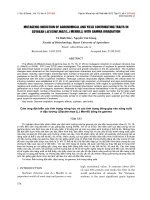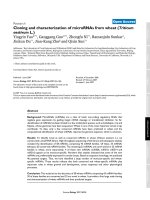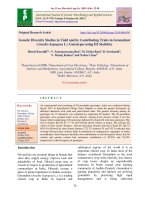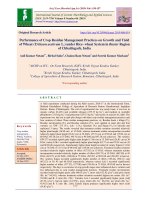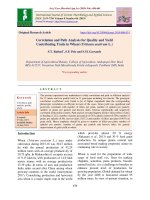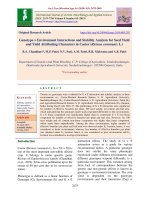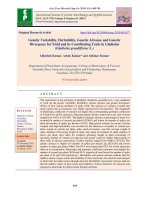Correlation and path analysis for quality and yield contributing traits in Wheat (Triticum aestivum L.)
Bạn đang xem bản rút gọn của tài liệu. Xem và tải ngay bản đầy đủ của tài liệu tại đây (258.26 KB, 6 trang )
Int.J.Curr.Microbiol.App.Sci (2019) 8(6): 456-461
International Journal of Current Microbiology and Applied Sciences
ISSN: 2319-7706 Volume 8 Number 06 (2019)
Journal homepage:
Original Research Article
/>
Correlation and Path Analysis for Quality and Yield
Contributing Traits in Wheat (Triticum aestivum L.)
S.T. Rathod*, S.P. Pole and S.M. Gawande
Department of Agricultural Botany, College of Agriculture, Ambajogai Dist. Beed
(MS) 431517, Vasantrao Naik Marathwada Krishi vidyapeeth, Parbhani (MS) India
*Corresponding author
ABSTRACT
Keywords
Correlation, path
analysis, quality,
wheat
Article Info
Accepted:
07 May 2019
Available Online:
10 June 2019
The present experiment was undertaken to study correlation and path co-efficient analysis
for 12 metric and two quality traits in 11 genotypes including two checks. The genotypic
correlation co-efficient were found to be of higher magnitude than the corresponding
phenotypic correlation co-efficient in most of the cases. Grain yield was significant and
positively correlated with number of tillers per plant, number of spikelet per panicle,
number of grains per panicle and harvest index whereas significantly and negatively
correlated with protein content. Path analysis revealed highest positive direct effect of days
to heading (1.212), number of grains per panicle (0.783), gluten content (0.709), number of
grains per spikelet (0.56), harvest index (0.512) and number of tillers per plant (0.493) on
grain yield. Hence emphasis should be given to number of tillers per plant, number of
spikelet per panicle, number of grains per panicle and harvest index for genetic
improvement of grain yield in wheat.
which provides almost 20 % energy
(Nukasani et al., 2013) and 30 % food grain
production. Its unique gluten content and
associated bread making properties assure its
continuing role in society.
Introduction
Wheat (Triticum aestivum L.) area under
cultivation during 2015-16 was 30.47 million
ha with the annual production of 92.29
million tones with an average productivity of
30.75 q/ha. In Maharashtra it occupies an area
of 9.13 lakh ha with production of 14.0 lakh
metric tonnes with an average productivity
15.39 q/ha. In terms of area and production
India ranks second after China among wheat
growing countries in the world (Anonymous
2017). Considering production and harvested
area wheat is a major staple crop in the world
Wheat is used for the preparation of wide
range of food stuff viz., flour for making
chapattis, semolina, pasta products, biscuits
animal feed etc. it is a challenge to breeders to
enhance present level of production for
growing population. Global demand for wheat
by the year 2020 is forecasted around 95
million tones. In view of present situation, to
456
Int.J.Curr.Microbiol.App.Sci (2019) 8(6): 456-461
increase area under production is not possible.
Only alternative with breeders is to increase
productivity by evolving high yielding
varieties and better crop management
practices to cope up with increasing demands
of food. Therefore efforts were made to study
correlation and path analysis in timely sown
irrigated wheat genotypes to determine
criteria for selection that could be used to
identify desirable genotypes with high yield
potential.
Results and Discussion
The genotypic correlation co-efficient were
found to be of higher magnitude than the
corresponding phenotypic correlation coefficient in most of the cases presented in
table 1. Genotypic correlation provides an
estimate of an inherent association between
genes controlling any two characters i.e.,
when two characters are invariably and nearly
associated, the underlined genetic mechanism
causing such association may be due to
complex linkage between the two characters
or pleiotrophy. Hence genotypic correlation is
of greater significance and can be effectively
utilized in the formulating an effective
selection programme.
Materials and Methods
The experimental material comprised of nine
(09) different genotypes of bread wheat and
two (02) check varieties were sown on 8th
November, 2016 under normal irrigated
condition during rabi 2016-17 in randomized
block design with three replication at
Experimental
Farm,
Department
of
Agricultural Botany, College of Agriculture,
Latur. Each genotype was planted in two rows
with plot size 3.40 X 0.4 m2 with 20 cm row
to row and 5 cm plant to plant distance.
Yield per plant had not only significant and
positive correlation with number of tillers per
plant, number of spikelet per panicle, number
of grains per panicle and harvest index but
also highly significant and positively
correlated with days to heading, days to 50 %
flowering and days to maturity. These results
are in agreements with earlier reports of
Kashte (2013) for days to maturity, Dabi et
al., (2016), for test weight and harvest index,
Singh (2016) for tillers per plant, harvest
index and days to maturity. Intercorrelations
among yield contributing traits revealed
highly significant and positive correlation
among length of panicle with number of
grains per spikelet and number of grains per
panicle at both genotypic and phenotypic
level.
All recommended agronomic practices were
followed to grow good crop. The observations
on 12 metric traits viz., plant height (cm),
days to heading, days to 50 per cent
flowering, days to maturity, number of tillers
per plant, length of panicle, number of
spikelet’s per panicle, number of grains per
spikelet, number of grains per panicle, test
weight, harvest index and yield per plant (g)
along with two quality traits viz., protein
content (%) and gluten content (%) were
recorded at proper growth stage. Five
randomly selected plants were recorded for all
the traits under study except of protein
content (%) and gluten content (%).Protein
content was estimated by Micro kjeldhal
method and gluten content by AOAC
procedure (1965). Correlation and path
analysis were estimated as per the method
suggested by Dewey and Lu (1959).
Days to maturity was significantly and
positively correlated with days to heading and
days to 50 % flowering at genotypic level.
Similar results were reported by Kashte
(2013) for length of panicle, number of grains
per panicle, number of grains per spikelet,
days to heading, days to 50 % flowering and
days to maturity, Dabi et al., (2016) for days
to heading and days to maturity.
457
Int.J.Curr.Microbiol.App.Sci (2019) 8(6): 456-461
Table.1 Genotypic and phenotypic (upper and lower diagonal respectively) correlation co-efficient among yield contributing and
quality characters in wheat
Character
1
1
2
3
4
5
6
7
8
9
10
11
12
13
14
-0.008
0.038
-0.047
-0.162
0.072
-0.070
0.233
0.024
0.164
-0.690**
0.151
0.149
-0.237
0.983**
0.997**
-0.147
0.488**
0.756**
0.876**
0.842**
0.011
0.064
-0.562**
0.234
0.580**
0.989**
-0.178
0.485**
0.759**
0.827**
0.808**
0.149
-0.014
-0.591**
0.348*
0.511**
-0.112
0.521**
0.770**
0.801**
0.814**
0.038
0.063
-0.574**
0.305
0.549**
-0.239
-0.502**
-0.361*
-0.443**
-0.192
-0.276
-0.143
0.234
0.379*
0.703**
0.683**
0.801**
-0.132
0.222
-0.195
-0.016
0.166
0.730**
0.943**
0.029
0.405**
-0.539**
-0.018
0.441*
0.923**
-0.310
-0.068
-0.216
-0.152
0.273
-0.153
0.248
-0.407*
-0.110
0.400*
0.195
-0.458*
0.610**
0.104
-0.370*
-0.224
0.386*
-0.203
-0.871*
2
0.002
3
0.044
0.969**
4
-0.044
0.970** 0.955**
5
-0.141
-0.153
-0.193
-0.115
6
0.079
0.405*
0.395*
0.419*
-0.165
7
-0.058
0.714** 0.708** 0.716**
-0.437*
0.695**
8
0.187
0.739** 0.688** 0.701**
-0.358*
0.457** 0.579**
9
0.023
0.805** 0.775** 0.796**
-0.425*
0.697** 0.907** 0.823**
10
0.160
0.012
0.141
0.025
-0.170
-0.125
0.029
-0.262
-0.159
11
-0.574**
0.074
0.034
0.087
-0.203
0.098
0.316
-0.124
0.202
0.173
12
0.133
-0.087
-0.160
-0.502**
-0.182
-0.384*
0.421*
0.279
13
0.147
0.215
0.323
0.292
0.232
-0.015
-0.019
-0.125
-0.108
0.603**
-0.212
-0.186
14
-0.211
0.520**
0.464**
0.515**
0.356*
0.111
0.387*
0.199
0.361*
0.104
0.426**
-0.738**
-0.576** -0.593** -0.560**
0.084
0.073
** and * indicates significant at 1% and 5%, respectively.
1=Plant height (cm), 2=Days to heading, 3=Days to 50% flowering, 4=Days to maturity, 5=Number of tiller/ plant, 6=Length of panicle (cm), 7=Number of
spikelet per panicle, 8=Number of grains per spikelet, 9=Number of grain per panicle, 10=1000 grain weight (g), 11=Harvest index (%), 12=Protein content (%),
13=Gluten content (%), 14=Yield/ plant (g)
458
Int.J.Curr.Microbiol.App.Sci (2019) 8(6): 456-461
Table.2 Direct and indirect effects (genotypic) of yield components on yield of wheat
Characters
Plant
height
(cm)
Days to
heading
Days to
Days to Number Length Number Number Number 1000 Harvest
50%
maturity
of
of
of
of
of grain grain
index
flowering
tillers/ panicle spiklets
grains
per
weight
(%)
plant
(cm)
per
per
panicle
(g)
panicle spiklets
0.0051
-0.0063
-0.0217 0.0097 -0.0094
0.0313
0.0032 0.0220 -0.0925
1.1930
1.2097
-0.1793 0.5921
0.9170
1.0633
1.0220 0.0143 0.0784
Plant height (cm)
Days to heading
0.1339
-0.0100
-0.0011
1.2129
Days to 50%
flowering
Days to maturity
-0.0135
-0.3442
-0.3500
-0.3464
0.0626
0.0866
-1.8223
-1.8084
-1.8271
0.2051
Number of tillers
per plant
Length of panicle
(cm)
Number of spikelet’s
per panicle
-0.0801
-0.0730
-0.0883
-0.0554
0.4937
-0.0411
-0.2760
-0.2744
-0.2947
0.1353
-0.0015
0.0164
0.0164
0.0167
Number of grains
per spikelet
Number of grain per
panicle
1000 grain weight
(g)
Harvest index (%)
0.1313
0.4925
0.4650
0.0189
0.6598
-0.0744
Protein
content
(%)
Gluten
content
(%)
0.0202
-0.6826
0.0200
0.2847
0.0049
0.2070
-0.1219
-0.1159
1.0501
-0.5585
-0.1365
-0.0711
0.1157
-0.1256
0.1105
0.0091
-0.2658
-0.2897
-0.2828
-1.4070
-1.4644
-1.4886
-0.2483
-0.1785
-0.2192
-0.3978
-0.3866
-0.4530
0.0524
0.0699
0.0952
0.0747
-0.0109
0.1698
0.9523
0.1181
0.5654
0.0152
0.0216
0.0158
0.0204
0.0006
0.0088
-0.0117
-0.0004
0.4503
-0.2030
0.3841
0.4104
0.5618
0.5189
-0.0385
-0.1214
-0.0856
0.6329
0.6380
-0.3476
0.6274
0.7388
0.7233
0.7830
0.1949
-0.3192
-0.0866
-0.0053
-0.0678
-0.0173
0.0873
0.0597
-0.0134
0.1404
0.0696
-0.0883
0.2074
-0.2760
-0.3538
0.0331
-0.0072
0.0325
-0.1416
0.1138
0.2079
-0.0351
0.1275
0.1743
0.1205
0.4523
0.1000
0.5122
-0.1898
-0.1149
Protein content (%)
-0.1401
0.5215
0.5482
0.5327
0.1334
0.1812
0.4998
0.2003
0.3778
0.4249
0.3434
-0.9268
0.1887
Gluten content (%)
0.1060
0.1666
0.2472
0.2170
0.1664
-0.0128
-0.1081
-0.0785
0.4330
-0.1593
-0.1445
0.7098
Yield per plant (g)
-0.2376
0.5809
0.5119
0.5494
0.3796
0.0115
0.1660
0.4410
0.2737
0.4003
0.1049
0.3861
-0.8718
0.0843
459
Int.J.Curr.Microbiol.App.Sci (2019) 8(6): 456-461
Days to heading, days to 50 % flowering and
days to maturity were highly significant and
positively correlated with length of panicle,
number of spikelet per panicle, number of
grains per spikelet and number of grains per
panicle at genotypic level. Similar results
were reported by Avinashe et al., (2015) for
days to heading, days to maturity, Dabi et al.,
(2016) for days to heading, days to maturity
and number of spikelet per panicle.
ICAR-Indian Institute of Wheat and
Barley Research, Karnal, India. P 87.
Avinashe, H. A., Shukla, R. S., Dubey, N. and
Jaiwar, S. (2015). Correlation and path
analysis for yield and yield contributing
characters in bread wheat (Triticum
aestivum L.) Electronic J. of Plant
Breeding, 6(2): 555-559.
Dabi, A., Mekbib, F. and Desalegn, T. (2016).
Estimation of genetic and phenotypic
correlation coefficients and path
analysis of yield and yield contributing
traits of bread wheat (Triticum aestivum
L.) genotypes. Inter. J. of Natural
Resource Eco.and Management., 1(4):
145-154.
Dewey, D. R. and Lu, K. H. (1959).A
correlation and path coefficient analysis
of component of crested wheat grass
seed production. Agron. J. 51: 515-518.
Kashte S. (2013). Stability analysis for yield
and quality traits in wheat (Triticum
aestivum L.). Thesis submitted to
V.N.M.K.V. Parbhani.
Nukasani V., Potdukhe, N. R.., Bharad W.,
Deshmukh S., and Shinde S. M. (2013).
Genetic variability, correlation and path
analysis in wheat.J. Wheat Res. 5(2):
48-51.
Parnaliya, J. B., Raiyani, G. D., Patel, K.,
Dabhi, K. H. and Bhatiya, V. J. (2015).
Genetic variability, correlation and path
analysis in bread wheat (Triticum
aestivum L.) genotypes under limited
water for timely sown condition.
AGRES- An International e-Journal
4:301-308.
Singh, B. K., and Chaudhary, B. D. (1977).
Biometrical methods in quantitative
genetic analysis. Kalyani publishers.
New Delhi,
Singh, T. (2016). Character association
analysis in durum wheat (Triticum
durum Desf.) Agric. Sci. Digest., 36(1):
24-29.
Tripathi, S. N., Marker, S., Pandey, P.,
In present study protein content was found
significantly and negatively correlated with
grain yield at genotypic and significantly and
positively correlated with grain yield at
phenotypic level.
The results of path co-efficient analysis
(Table 2) revealed that days to heading
exerted the highest positive direct effect on
grain yield followed by number of grains per
panicle, number of grain per spikelet, harvest
index and number of tillers per plant. Similar
results were reported by Tripathi et al.,
(2011). The highest negative direct effect on
grain yield was recorded for days to maturity,
protein content, length of panicle, 1000 grain
weight and days to 50 % flowering. Parnaliya
et al., (2015) also reported negative direct
effect of days to maturity, number of tiller per
plant and ear length on grain yield which
supports our findings.
Hence emphasis should be given to number of
tillers per plant, number of spikelet per
panicle, number of grains per panicle and
harvest index for genetic improvement of
grain yield in wheat.
References
Anonymous (2017).Progress report
India Coordinated Wheat and
Improvement Project 2016-17,
Director’s Report. Ed. G.P.
of All
Barley
Project
Singh,
460
Int.J.Curr.Microbiol.App.Sci (2019) 8(6): 456-461
Jaiswal, K. K. and Tiwari, D. K.,
Relationship
between
some
morphological and physiological traits
with grain yield in bread wheat
(Triticum aestivum L.). Trends Appl.
Sci. Res. 6: 1037-1045 (2011).
How to cite this article:
Rathod, S.T., S.P. Pole and Gawande, S.M. 2019. Correlation and Path Analysis for Quality
and Yield Contributing Traits in Wheat (Triticum aestivum L.). Int.J.Curr.Microbiol.App.Sci.
8(06): 456-461. doi: />
461
